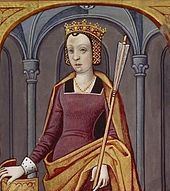 | ||
Similar Works by Giovanni Boccaccio, Renaissance books | ||
De Mulieribus Claris or De Claris Mulieribus (Latin for "Concerning Famous Women") is a collection of biographies of historical and mythological women by the Florentine author Giovanni Boccaccio, first published in 1374. It is notable as the first collection devoted exclusively to biographies of women in Western literature. At the same time as he was writing On Famous Women, Boccaccio also compiled a collection of biographies of famous men, De Casibus Virorum Illustrium (On the Fates of Famous Men).
Contents
Purpose
Boccaccio claimed to have written the 106 biographies for the posterity of the women who were considered renowned, whether good or bad. He believed that recounting the deeds of certain women who may have been wicked would be offset by the exhortations to virtue by the deeds of good women. He writes in his presentation of this combination of all types of women that hopefully it would encourage virtue and curb vice.
Overview
The author declares in the preface that this collection of 106 short biographies (104 chapters) of women is the first example in Western literature devoted solely and exclusively to women. Some of the lost works of Suetonius' "illustrious people" and Boccaccio's De Casibus Virorum Illustrium are a mixture of women and men, where others like Petrarch's De Viris Illustribus and Jerome's De Viris Illustribus are biographies of exclusively men. Boccaccio himself even says this work was inspired and modeled on Petrarch's De Viris Illustribus.
Boccaccio's collection of female biographies inspired characters in Christine de Pizan's The Book of the City of Ladies, Alvaro de Luna's De las virtuosas y claras mujeres, Thomas Elyot's Defence of Good Women, Alonso of Cartagena's De las mujeres ilustres, Giovanni Sabbadino degli Arienti's Gynevera de la clare donne, Iacopo Filippo Forest's De plurimis claris selectisque mulierbus, Jean Lemaire's Couronne margaritique, and various works by Edmund Spenser. It also had influence on Geoffrey Chaucer's Legend of Good Women and The Canterbury Tales. Boccaccio's work has much respect in the history of Western literature and is a fountainhead for European women biography.
Development
Boccaccio wrote this work in Certaldo probably between the summer of 1361 and the summer of 1362, although it could have been as late as December 1362. He dedicated his work to Andrea Acciaioli, Countess of Altavilla, in Naples at the end of 1362 even though he continued to revise it up until his death in 1375. She was not his first choice however. He first considered to dedicate his slim volume to Joanna I of Naples. He ultimately decided that his work as a little book was not worthy a person of such great fame.
There are over 100 surviving manuscripts which shows that the De Mulieribus Claris was "among the most popular works in the last age of the manuscript book". Boccaccio worked on this as a labor of love with several versions, editions, and rearrangements in the last twenty years or so of his life: studies have identified at least nine stages in its composition. In the last part of the 14th century after Boccaccio died a Donato degli Albanzani had a copy that his friend Boccaccio gave him and translated it from Latin into Italian. In the early part of the 15th century Antonio di S. Lupidio made a volgare translation and Laurent de Premierfait put it in French as Des cleres et nobles femmes while later Heinrich Steinhowel rendered it into German. In the beginning of the 16th century a Henry Parker translated about half into English and dedicated it to Henry VIII. This was then followed in the 16th century of other Italian translations by Luca Antonio Ridolfi and Giuseppe Betussi.
The invention of the printing press brought the first Latin version done by Johan Zainer in Ulm about 1473. The only complete 16th century printed Latin version to survive is from a Mathias Apiarus done around 1539. From that time it was not until the middle of the 20th century until there was another complete printed version done – some 400 years later.
Content
The 106 Famous Women biographies are of mythological and historical women, as well as some of Boccaccio's Renaissance contemporaries. The brief life stories follow the same general exemplary literature patterns used in various versions of De viris illustribus. The biography pattern starts with the name of the person, then the parents or ancestors, then their rank or social position, and last the general reason for their notoriety or fame with associated details. This is sometimes interjected with a philosophical or inspirational lesson at the end.
The only sources that Boccaccio specifically says he used are Saint Paul (no. 42), the Bible (no. 43) and Jerome (no. 86). The wording of the biographies themselves, however, provide hints about where he obtained his information. He clearly had access to works of the classical authors Valerius Maximus, Pliny, Livy, Ovid, Suetonius, Statius, Virgil, Lactantius, Orosius, and Justinus.
